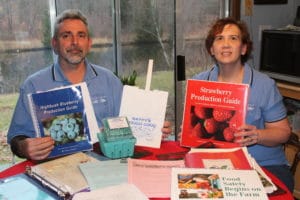Growers Credit NY Berry Project for Successful Start-Up
If you’re thinking about starting a farm enterprise focused on growing berries, Elaine and Karl Guppy will tell you to go to back to school at Cornell University first.
“We have taken almost every production and business management workshop offered by the Cornell University New York Berry Project,” Elaine says. “The learning opportunities are packed with so much information, it is like taking an entire Cornell course in one day, and they are often free.”
The New York Berry Project makes the expertise of Cornell’s Horticulture Department Chair Dr. Marvin Pritts and Cooperative Extension fruit specialists Cathy Heidenreich and Laura McDermott available to growers statewide.
The project has funding from the New York Farm Viability Institute to offer workshops, webinars, on-farm demonstrations, and one-on-one interaction.
Elaine and Karl operate Guppy’s Berry Farm, LLC in West Monroe, NY, and say learning all they could before they began preparing their land was a key to their start-up success.

Karl and Elaine Guppy with some New York Berry Project educational resources they used to begin and grow their farming enterprise. Photo by Brian P. Whattam.
“The Berry Project was invaluable to helping us get started with wonderful technical support. When we started, we only knew we wanted to plant berries,” Elaine says.
The Guppys have attended workshops, taken field trips, and visited the Cornell berry plots. They avidly read the New York Berry News published 12 times a year with the latest research information from Cornell and the USDA, Berry Barometer month-by-month tips for the best cultural practices and pest management solutions, policy and regulation news, and workshop and event notices. Growers can find it online or request a monthly e-mail notification of the contents.
“One of the biggest tips Dr. Pritts gave us early on was to test our soil and make sure we had the right nutrients for blueberries,” Karl says. “We learned everything we could about pH, soil testing, fertilizers, etc.”
In 2008, they removed pinewoods from five acres and, a year later, they established their LLC.
In 2010, they hand-planted 2,000 certified disease-free blueberry plants, painstakingly measuring spacing between plants and rows.
“Cathy’s advice helped us select the best varieties for fresh flavor, shelf life, and disease resistance, which was especially important for us as new growers to not have to deal with issues such as mummy berry,” Elaine says.
In 2011, when an early frost destroyed nearly one-half of their crop and then Japanese beetles arrived, the Guppys turned to the berry team for training on temperature moderation methods, irrigation, and pest control.
Other Resources for Northeast Berry Growers
- Berry Crop Label Alerts – The latest registrations, updates, label changes, and more.
- Pest Management Guidelines for Berry Crops – Critical pesticide information for managing diseases, insects, mites, weeds, wildlife, and nutrients.
- Berry Diagnostic Tool – A pictorial aid to diagnosing physiological disorders and pest problems of berry crops. Includes direct links to Pest Management Guidelines for Berry Crops from pest description pages.
- Nursery Guide for Berry and Small Fruit Crops – This two-part nursery guide for berry growers cross references scores of cultivars with the nurseries that sell them.
- Berry Webinar Archive – View and listen to online berry web seminars on topics including weed control, varieties, insects, and nutrient needs.
“They are always just a call, email, or workshop away,” Elaine says.
The Guppys dug a pond and added irrigation to their fields. Karl built a motion sensor tower that triggers a radio and light show that has successfully kept deer out of the berries. He constructed bat boxes that attract the night fliers to help control some pests.
The Project leaders helped the Guppys identify USDA grant funding to help pay for development of marketing materials, including product packaging, labels, and signage with a distinctive farm logo.
A primary sales point is the Syracuse Regional Market, about a 35-minute drive from the farm.
“There are a lot of farms selling blueberries at the market – three in my row alone, but people have taken the time to get to know us and our berries and now they search for our booth,” Elaine says.
Their continuing education plan in 2013 has them completing their Good Agricultural Practices certification.
“We are still learning and planning to enlarge our business as we approach retirement. It is great to work with the Cornell people who study berries and know what we should do and not do before we do it,” Karl says.
“We wouldn’t be where we are today without the experience and knowledge the New York Berry Project shared to get us started,” Elaine adds.
The Guppys see a future with more blueberry plants, a low tunnel for ever-bearing strawberry production, expanded blackberry production, and perhaps some juneberries (they attended a September 2012 workshop on juneberries, which like soil conditions similar to blueberries).
A daughter-in-law has expressed interest in starting a commercial kitchen to make jams and other value-added products.
For its part, the New York Farm Viability Institute (NYFVI) has also funded high tunnel season extension research and value-added crop enhancement opportunities for berry growers.
In 2013, with NYFVI funding, Dr. Pritts began recruiting commercial growers who have been in business at least three years and with sales, preferably of two types of berries, in 2012 to evaluate the use of a berry farm-specific business summary. Horticultural marketing expert Dr. Bradley Rickard with the Dyson School of Applied Economics and Management at Cornell is part of the evaluation team.
The farm business summary project will collect crop production data for developing crop budgets for strawberry, blueberry and raspberry crops, and will collect economic data to create benchmarks for business evaluation. This effort builds on the Cornell-developed Fruit Farm Business Summary successfully used by tree fruit growers to improve their return-on-investment for more than 10 years.
No doubt the Guppys will make good use of that berry business training in the future.

